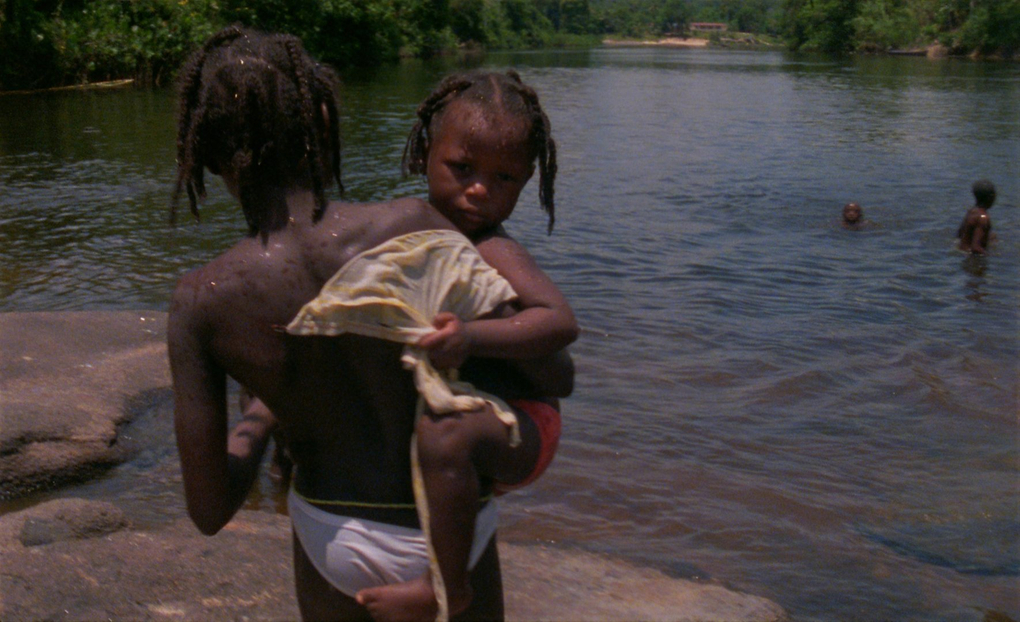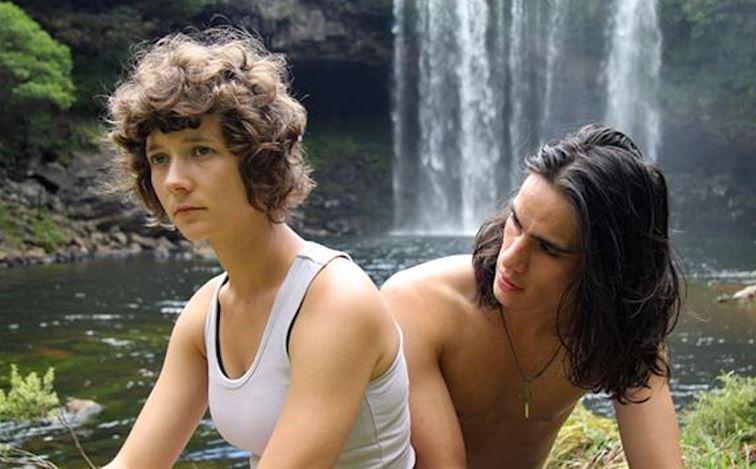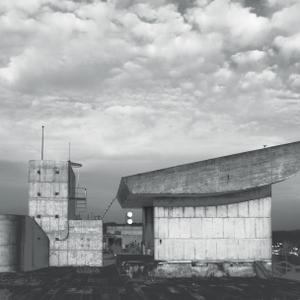This Fine Island (2012) Gavin Hipkins
review by Tessa Laird
Hipkins' photographs often juxtapose figure and field, in particular three-dimensional objects in relation to photographic reproductions. Lollies on magazines; buttons on modernist masterpieces; Hipkins' pairings are jarring, but fond. Transferring his intertextual skills into the world of film, Hipkins uses the diary entries of the young Charles Darwin on his Beagle Voyage to frame a contemporary narrative.
The colonial experience is writ large on This Fine Island, with Darwin's bemused take on the Bay of Islands as the voice track to a young backpackers' camping holiday. It's a tale of summer love between a European girl and a Māori boy: the traveler and the local. Desire, mistrust, incomprehension are tossed into the mix, but lightly, like the hackysack balls the boy tosses against a ferny canopy. One of the film's most enduring images, it sums up the film: slick and homespun, with a disarming sweetness.
The Two Bens: Short Films by Ben Rivers and Ben Russell (2010-11)
review by Martin Rumsby
Most of the work in this programme by the English (Rivers) and American (Russell) sometime collaborators inhabited an intersection between ethnographic, documentary and experimental cinemas. The exception, Russell’s Trypps #7 (Badlands) (10m, 2010) represented a South Dakota landscape with young woman in it and utilized strategies that lay somewhere between the landscape films of Michael Snow and Stan Brakhage.

Still from Trypps#7 (Badlands) (2010) Ben Russell
Rivers’ Sack Barrow (21m, 2011) depicted workers going about their daily duties in an English electroplating factory. (Something we are familiar with from earlier work by Darcy Lange and Louis Malle).
Russell’s River Rites (12 minutes, 2011) was an extended shot of village children playing in a river in Suriname, but with the action reversed, so that all movement was backward. I suspect it to be an out-take from Russell’s earlier Let Each One Go Where He May (135m, 2009).
Slow Action (40m, 2011) by Rivers was shot in the ‘potential’ utopias of Hiva, Lanzarote, Hashima and Tuvalu. But for Rivers utopia is a hollow dream that can be approached, but never attained; something like Colin McCahon’s notion of a ‘promised land’.
Generally, Rivers’ work was more literary and his photographic shots more formally composed than Russell’s seeming informality. I am hoping that the Auckland Film Festival will someday mount a comprehensive retrospective of James Benning’s films. Read about Ben Russell’s Let Each One Go Where He May in Millennium Film Journal #56, due out in October, 2012.
Marina Abramovic: The Artist is Present (2012) Matthew Akers
review by David Cross
Marina Abramovic: The Artist is Present does a nice job of capturing both what is highly compelling and slightly irksome about this important figure of performance art.
The film takes us into the preparations and subsequent realisation of her recent retrospective at MOMA with a faux fly-on-the-wall mode. This "inside" take positions us in the midst of the action from when key decisions are made through to the the artist's "triumph" at the end of the exhibition when she makes it through three months of silently looking at mostly strangers in front of her. Interspersed are flashbacks to key works from the 70s and 80s with Abramovic recounting how and why she made her influential transgressive body projects. This is by far the most interesting and revealing aspect of the film with the artist offering thoughtful yet never indulgent insights into the evolution of her work.

Still from Marina Abramovic: The Artist is Present (2012)
Where it starts to get bogged down is when the film makers stage Ulay's reappearance in Abramovic's life. The effect is more This Is Your Life than considered reflection and it becomes a sort of tragedy about the lost love of the artists life. Ulay to his credit is never comfortable with the scenario and does a good job of short-circuiting the seriousness of the rapprochement.
While always watchable, Marina Abramovic: The Artist is Present is never anything but a love letter to the artist. Everyone loves her including her assistants, her dealer and in a hilarious scene the magician David Blane, who convinces her they should work together.
But a good biopic also needs the underbelly—some rough to temper the smooth—especially in terms of the issues surrounding her re-staged performances with younger, mostly nubile performers for the MOMA show. The film never challenges the Abramovic brand and its rudimentary attempts at franchising performance even though so many of the recent projects within museum contexts feel watered down and sanitised.
antoinepoupel.jpg)
Still from Crazy Horse (2011) ©Antoine Poupel
Crazy Horse (2011) Frederick Wiseman
review by Megan Dunn
Whilst a female leg in black silk stockings can never be too long, a film can. Like a regular drinking at the back of The Crazy Horse, director Frederick Wiseman lingers under the stage lights—the flare of red—the flash of midnight blue—and holds his gaze. It’s easy to understand his fascination with this club—the dance sequences are incredible. However, burlesque and the timeless art of the striptease are now as mainstream as McDonalds. Middle-aged couples pose for their photos in the subterranean gloom of the Crazy Horse. On the Monday night I went to the Embassy to see Wiseman’s documentary, plenty of young women were also in attendance, their lips deeply red, fifties haircuts worn with panache. I’m sure most of them now aspire to strip to an Antony and the Johnsons song on a chaise lounge, or to tie their naked bodies in red rope, suspended from the stage, as though from a celestial swing. Why not? Dreams are free; but at The Crazy Horse there’s a door charge.

Still from River Rites (2012) Ben Russell
The Two Bens: Short Films by Ben Rivers and Ben Russell (2010-2011)
reviewed by Peter Wareing
Sack Barrow by the British film maker Ben Rivers is a testament to the older ways of doing things, or older media, and by watching this 16mm colour film with the chance flares of light, scratches and dust we become aware that he is quite capable of continuing with innovations regardless of the new forms of production. My sense with this kind of cinema, he proposes—if we wish to remain alert to what is new, we need to be alert to what can be revived among the detritus of our culture.
River’s interest in constructed realities is underscored by the way he focuses primarily upon the environments that his most often cloistered subjects create for themselves, in this case it is a small factory that has seen the end of its days. Sack Barrow formally belongs to the documentary genre, but it also combines the very nature of film as a material into this structure. Ben Rivers use of film as not only a device to tell a story but also reminds use of the DNA of moving image, light through a lens coupled with a simple story. Rivers' obsession with the "outdated"—that which is somehow suspended out of time—is reflected in the slow decay of the factory's Industrial Age machines.
The four-part microcosmic study Slow Action filmed in anamorphic 16mm film, uses the document in a wholly different way. This time fictional elements in the form of invented characters or constructed enigma’s, aided by voice-over or animation are edited with the pictorial document. Stretching across space and time the illusion is always broken by reflexively allowing the medium of film to interrupt the scenes. Content is always conditional on the fact that the medium is degraded and that it is mad with allusions to the strangest kind of science fiction or b-grade props.
In Ben Russell’s Trypps#7 (Badlands), the character portrait seems as if in an altered state and where the image and sound operate in their own terms. We discover nothing psychologically of the woman and we know nothing of the relationship she has with her environment. The film operates as if in a daze and is a long way from the traditional film portrait but is also not the self that Hal Foster has claimed is "all image and no interiority"; this portrait flirts between these two domains.
The same can be said of Russell’s River Rites where a camera traverses in one take, the banks of a river in Suriname. It is a pastoral scene where children play on and in the river while a fisherman attends his nets. What appears to be a staged action is undone by the simple act of reversing the whole 10-minute scene. So what would appear familial now becomes alien, adding to this estrangement is the very urban experimental noise/sound track. The film-maker self consciously disturbs the picturesque idyll by collapsing the cultural space and reflexively disembodying the action, which suddenly puts us into a very different kind of space and time.
Like Ben Rivers, Ben Russell reveals that our relationship with a mediated world is a complex affair, and ultimately, the most critical information in the films is in the subtext. River Rites, Sack Barrow and Slow Action all configure a precarious consciousness embedded in a fictionalised reality. Paradoxically, as their characters seem to exist outside our very mediated world they are revealed to us mediated, as part document, part fiction.

